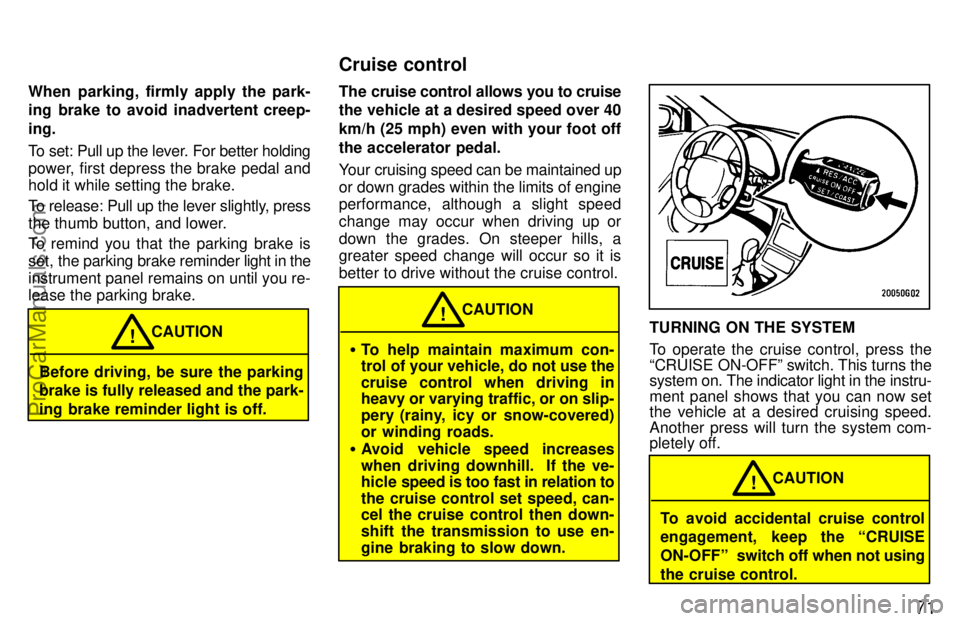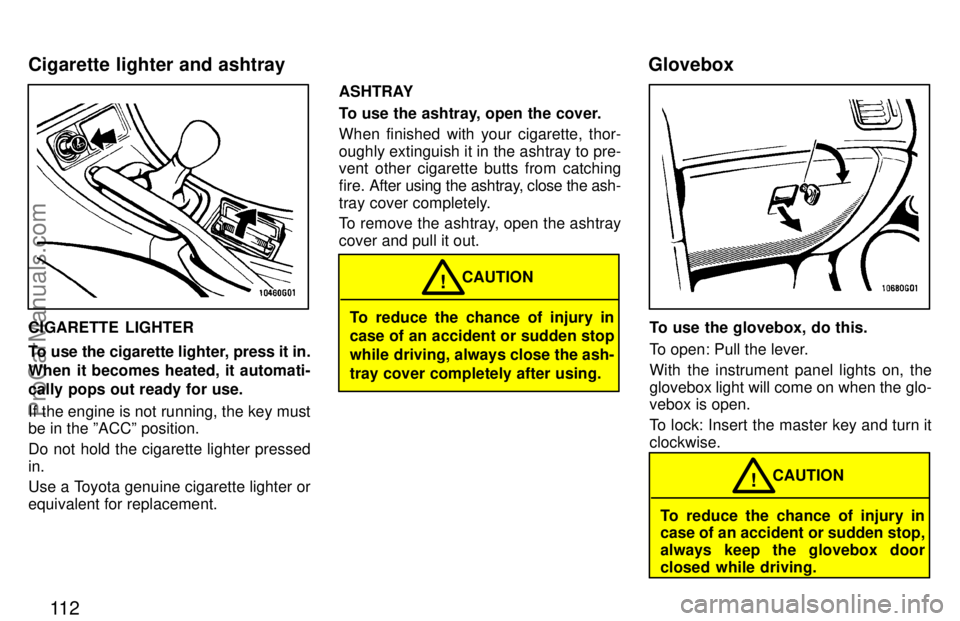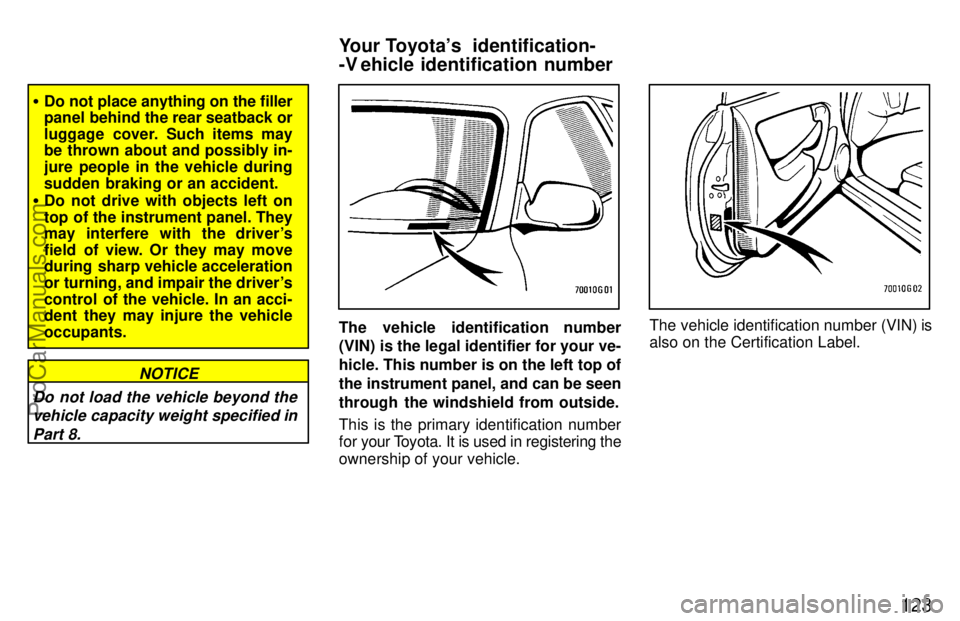Page 76 of 218

71
When parking, firmly apply the park-
ing brake to avoid inadvertent creep-
ing.
To set: Pull up the lever. For better holding
power, first depress the brake pedal and
hold it while setting the brake.
To release: Pull up the lever slightly, press
the thumb button, and lower.
To remind you that the parking brake is
set, the parking brake reminder light in the
instrument panel remains on until you re-
lease the parking brake.
Before driving, be sure the parking
brake is fully released and the park-
ing brake reminder light is off. CAUTION
!
The cruise control allows you to cruise
the vehicle at a desired speed over 40
km/h (25 mph) even with your foot off
the accelerator pedal.
Your cruising speed can be maintained up
or down grades within the limits of engine
performance, although a slight speed
change may occur when driving up or
down the grades. On steeper hills, a
greater speed change will occur so it is
better to drive without the cruise control.
�
To help maintain maximum con-
trol of your vehicle, do not use the
cruise control when driving in
heavy or varying traffic, or on slip-
pery (rainy, icy or snow-covered)
or winding roads.
� Avoid vehicle speed increases
when driving downhill. If the ve-
hicle speed is too fast in relation to
the cruise control set speed, can-
cel the cruise control then down-
shift the transmission to use en-
gine braking to slow down. CAUTION
!TURNING ON THE SYSTEM
To operate the cruise control, press the
CRUISE ON-OFFº switch. This turns the
system on. The indicator light in the instru-
ment panel shows that you can now set
the vehicle at a desired cruising speed.
Another press will turn the system com-
pletely off.
To avoid accidental cruise control
engagement, keep the CRUISE
ON-OFFº
switch off when not using
the cruise control. CAUTION
!
Cruise control
ProCarManuals.com
Page 80 of 218
Part 1Car audio systemÐ
ÐReference75
OPERATION OF
INSTRUMENTS AND
CONTROLSÐ
Chapter 1-7
Car audio system
and Air conditioning
system
Car audio system
�Reference
� Using your audio system: some
basics
� Using your audio system:
controls and features
� Anti-theft system
� Car audio system operating
hints
Air conditioning system
� Controls
� Operating Tips
� Instrument panel ventsType 1: AM´FM ETR radio
Type 2-1: AMV FM ETR radio/cassette
player
Type 2-2: AM´FM ETR radio/cassette
player
Type 2-3: AMV FM ETR radio/cassette
player
ProCarManuals.com
Page 110 of 218

105
Fan speed selector
Turn the knob to adjust the fan speed ± to
the right to increase, to the left to de-
crease.
Temperature selector
Turn the knob to adjust the temperature ±
to the right to warm, to the left to cool.
Air flow selector
Press one of the buttons to select the
vents used for air flow. An indicator light
will illuminate to show which air flow mode
is being selected.
1 Panel ÐAir flows mainly from the in-
strument panel vents.
2 Bi-level ÐAir flows from both the
floor vents and the instrument panel
vents.
3 Floor ÐAir flows mainly from the floor
vents.
4 Floor/Windshield ÐAir flows mainly
from the floor vents and windshield vents.
5 Windshield ÐAir flows mainly from
the windshield vents. For details about air flow selector settings,
see the illustration after A/Cº button.
Vehicles with A/Cº buttonÐ
Pressing the windshield button turns on
the defroster-linked air conditioning. At
this time, the A/Cº button indica
tor comes
on regardless of whether or not the A/Cº
button is pressed in. This is to clean up the
front view more quickly.
When the A/Cº button is not pressed in,
pressing another air flow button pressing
and the turns off the air conditioning.
ProCarManuals.com
Page 114 of 218
109
The outside of the windshield
For best results, set controls to:Fan speedÐAny setting except OFFº
Temperature Ð Towards WARM
(red zone)
Air intakeÐ FRESH (outside air)
Air flowÐ WINDSHIELD
Vehicles with A/Cº buttonÐ
Turning the air flow control knob to wind-
shield position turns on the defroster-
linked air conditioning. At this time, the
A/Cº button indicator comes on regard-
less of whether or not the A/Cº button is
pressed in. This is to clean up the front
view more quickly.
When the A/Cº button is not pressed in,
moving the air flow control lever to anoth-
er position turns off the air conditioning.
�To heat the vehicle interior while de-
frosting the windshield, choose floor/
windshield air flow.
If air flow control is not satisfactory, check
the instrument panel vents. The instru-
ment panel vents may be opened or
closed as shown.
ÐInstrument panel vents
ProCarManuals.com
Page 116 of 218
Part 1Clock111
OPERATION OF
INSTRUMENTS
AND CONTROLSÐ
Chapter 1-8
Other equipment
�Clock
� Cigarette lighter and ashtray
� Glovebox
� Auxiliary
� Cup holder
� Luggage cover
� Floor mat
The digital clock indicates the time.
The key must be in the ``ACCº or ``ON''
position.
To reset the hour: Push the Hº button.
To reset the minutes: Push the Mº button.
If quick adjustment to a full hour is de-
sired, push the :00º button.
For example, if the :00º button is de-
pressed when the time is between
1:01Ð1:29, the time will change to 1:00.
If the time is between 1:30Ð1:59, the time
will change to 2:00. Once the electrical power source has
been disconnected from the clock, the
time is automatically set to 1:00 (one
o'clock).
When the instrument panel lights are
turned on, the brightness of the time indi-
cation will be reduced.
ProCarManuals.com
Page 117 of 218

11 2
CIGARETTE LIGHTER
To use the cigarette lighter, press it in.
When it becomes heated, it automati-
cally pops out ready for use.
If the engine is not running, the key must
be in the ºACCº position.
Do not hold the cigarette lighter pressed
in.
Use a Toyota genuine cigarette lighter or
equivalent for replacement.ASHTRAY
To use the ashtray, open the cover.
When finished with your cigarette, thor-
oughly extinguish it in the ashtray to pre-
vent other cigarette butts from catching
fire. After using the ashtray, close the ash-
tray cover completely.
To remove the ashtray, open the ashtray
cover and pull it out.To reduce the chance of injury in
case of an accident or sudden stop
while driving, always close the ash-
tray cover completely after using.
CAUTION
!
To use the glovebox, do this.
To open: Pull the lever.
With the instrument panel lights on, the
glovebox light will come on when the glo-
vebox is open.
To lock: Insert the master key and turn it
clockwise.
To reduce the chance of injury in
case of an accident or sudden stop,
always keep the glovebox door
closed while driving.
CAUTION
!
Cigarette lighter and ashtray Glovebox
ProCarManuals.com
Page 124 of 218

11 8
�Do not allow the engine to run atidle speed for more than 20 min-utes.
�Avoid racing the engine.�Do not push-start or pull-start
your vehicle.
�Do not turn off the ignition whilethe vehicle is moving.
�Keep your engine in good running
order. Malfunctions in the engine electrical system, electronic igni-tion system/distributor ignition
system or fuel system couldcause an extremely high three-
way catalytic converter tempera-ture.
�If the engine becomes difficult tostart or stalls frequently, take your
vehicle in for a check-up as soon
as possible. Remember, your To-yota dealer knows your vehicle
and its three-way catalytic con-verter system best.
�To ensure that the three-way cata-lytic converter and the entire
emission control system operateproperly, your vehicle must re-ceive the periodic inspections re-
quired by the T oyota Maintenance
Schedule. For scheduled mainte-
nance information, refer to theseparate Owner's Manual Sup-
plement/Maintenance Scheduleº.
CAUTION!
� Avoid inhaling the engine ex-
haust. It contains carbon monox-
ide, which is a colorless and odor-
less gas. It can cause uncon-
sciousness or even death.
� Make sure the exhaust system
has no holes or loose connec-
tions. The system should be
checked from time to time. If you
hit something, or notice a change
in the sound of the exhaust, have
the system checked immediately.
� Do not run the engine in a garage
or enclosed area except for the
time needed to drive the vehicle in
or out. The exhaust gases cannot
escape, making this a particularly
dangerous situation.
� Do not remain for a long time in a
parked vehicle with the engine
running. If it is unavoidable, how-
ever, do so only in an unconfined
area and adjust the heating or
cooling system to force outside
air into the vehicle.
�Keep the trunk lid or back door
closed while driving. An open or
unsealed trunk lid or back door
may cause exhaust gases to be
drawn into the vehicle. If you
must drive with the trunk or back
door lid open to accommodate a
large object, close the windows,
open all the instrument panel
vents and have the heating or
cooling system deliver fresh air
into the vehicle by turning the fan
to high speed with the air intake
control lever set at the outside air
position.
� To allow proper operation of your
vehicle's ventilation system, keep
the inlet grilles in front of the
windshield clear of snow, leaves,
or other obstructions.
� If you smell exhaust fumes in the
vehicle, drive with the windows
open and the trunk lid or back
door closed. Have the cause im-
mediately located and corrected.
Engine exhaust cautions
ProCarManuals.com
Page 129 of 218

123
�Do not place anything on the filler
panel behind the rear seatback or
luggage cover. Such items may
be thrown about and possibly in-
jure people in the vehicle during
sudden braking or an accident.
� Do not drive with objects left on
top of the instrument panel. They
may interfere with the driver's
field of view. Or they may move
during sharp vehicle acceleration
or turning, and impair the driver's
control of the vehicle. In an acci-
dent they may injure the vehicle
occupants.
Do not load the vehicle beyond the
vehicle capacity weight specified in
Part 8.
NOTICE
The vehicle identification number
(VIN) is the legal identifier for your ve-
hicle. This number is on the left top of
the instrument panel, and can be seen
through the windshield from outside.
This is the primary identification number
for your T oyota. It is used in registering the
ownership of your vehicle.The vehicle identification number (VIN) is
also on the Certification Label.
Your Toyota's identification-
-V ehicle identification number
ProCarManuals.com